|
In 1949, a young inventor named
William
B. Ruger (who would in time become known as the greatest firearms designer
since John M. Browning) approached a young financier named Alex Sturm with
a prototype of a new .22 rimfire semi-auto pistol. The pistol was a
soundly designed piece that was inexpensive to produce, reliable, and had
pleasing lines to boot. Ruger had the original design and the
manufacturing knowledge to make it a reality, but he needed the venture
capital required to start his company. Sturm, a young aristocrat with a
love of sport shooting, invested $50,000, and Sturm, Ruger & Co. was
born. A favorable review by Maj. Gen. Julian S. Hatcher, then Technical
Director for the NRA, brought the innovative new .22 to the attention of
the American gun buyer as a fine, reliable little .22 that could be had at
a very economical price.
Thus, Sturm, Ruger & Co. began a journey that would lead to the
company becoming the largest and most respected manufacturer of sporting
firearms in the U.S. Almost unheard-of in the manufacturing industry was
(and is) Ruger’s practice of corporate growth through reinvestment of
earnings. Such common-sense business practices have allowed Ruger to
operate “in the black” through its entire history, posting profits
each and every year and never once borrowing a penny. This is a testimony
not just of Sturm, Ruger & Co.’s financial savvy, but also of the
consistently excellent design and manufacture of its products and the
esteem for Ruger’s products held by sportsmen, military agencies and
police departments worldwide.
The little gun that started it all was a simple, reliable and attractive
.22 rimfire blowback-operated semi-automatic pistol with a tubular
receiver and a cylindrical bolt, a distinctive slim-tapered barrel, and a
profile that was somewhat reminiscent of the famed German Luger pistol.
The Ruger .22 pistol was blued steel with the bolt “in the white” or
unfinished so as to give an attractive contrast to the blued steel
receiver.
Ruger’s .22 auto pistols have been in continuous production throughout
the life of the company, and millions have been produced to date. It is
available today in many different variants: standard or target models,
fixed or adjustable sights, short or long barrels, tapered or bull
barrels, stainless or blued steel, and even steel or polymer frames with
different grip angles.
Our test gun for this article is one of the excellent 50th
Anniversary models produced in 1999 and part of 2000 as a limited-run
commemorative model. It is not an exact reproduction of the 1949 pistol,
however, as some changes have been made to the pistol since its inception,
both for safety and ease of use. Ruger began referring to their pistols as
“Mark Series” pistols once the changes began, and current pistols are
known (and roll-marked) as “Mark II” guns. Among the changes through
the years is an improved safety system, and a device to hold the bolt open
after the magazine is emptied (with an accompanying bolt drop lever). The
current production Ruger .22 pistol should be very familiar to most, so I
will not discuss the standard features at length, other than to describe
the differences in the 50th Anniversary Model.
The 50th Anniversary Model is
in essence a Standard Model .22 Auto with features reminiscent of very earliest models. Probably the most
noticeable of these features are the grip medallions, which are set into each black plastic checkered grip panel. Alex
Sturm himself, who was a student of heraldry, originally designed
Ruger’s distinctive trademark “eagle” logo, and at the company’s
inception the grip medallions featured a red eagle. Upon Sturm’s
untimely death in 1950, Ruger ordered that henceforth the grip medallions
would no longer feature a red eagle, in memory of his friend and business
partner. The medallions were initially changed to feature a black eagle,
and over the years a silver eagle on a black background became the
standard. The 50th Anniversary Model invokes the spirit of the
original medallions by featuring a silver eagle on a red background.
This logo is also set into the bottom of the two magazines
that are included with each gun (nice touch, Ruger!).
Another feature not seen on Ruger’s
.22 pistols since the earliest production models is the contrasting color
bolt. Originally, the pistols featured bolts that were unfinished, or
“in the white”, to create an attractive contrast with the blued steel
receiver. The 50th Anniversary Model features a similar
concept, but given that Ruger was a pioneer in the use of stainless steel
in firearms manufacture, the bolts are now unfinished stainless steel.
This offers the same contrast in appearance without the corrosion problems
inherent in unfinished carbon steel. Another difference relating to the
bolt is that the Ruger logo is roll-marked on the flat end of the bolt,
which is a very attractive touch not included on the current production
model. Also, one of the changes Ruger made with the introduction of the
“Mark Series” was to begin milling angled flats on the back of the
receiver immediately ahead of the bolt’s cocking “ears” in order to
make the bolt “ears” easier to grasp. These flats are omitted on the
50th Anniversary Model to give the gun an appearance more like
the originals.
The 50th Anniversary
Ruger logo is roll-marked on top of the receiver, between the barrel and
the ejection port, further identifying the gun as a limited-edition model.
The 50th Anniversary logo is also reproduced in color on the
top of the special red plastic box.
Shooting the test gun was a real
pleasure, especially considering that Jeff and I tested the gun on the
same day that we were developing heavy cast bullet loads for the .44
Magnum (see Jeff's article at Cast Performance). The little .22 was a real change of pace!
I have always greatly admired the handling qualities of these guns, and
this one was certainly no exception. They point like a dream, and if you
have ever handled an Olympic free pistol, the similarities in grip angle
and girth are readily apparent. These are quality-built, extremely well
designed guns, and the accuracy they exhibit is what one would expect from
Ruger: in a word, excellent. Two inch groups at twenty-five yards from a
bench rest was achieved with almost boring regularity with any ammunition
tried, except Winchester’s Xpediter 29-grain loads, which grouped closer
to four inches and failed to register on our Pact chronograph 90% of the
time. With ammunition it “liked”, such as Winchester’s standard
Super-X, group sizes of close to one inch were not uncommon. The excellent handling
qualities of this gun, coupled with the light recoil of the .22 cartridge,
assured that anything over three inch groups offhand were my fault, not
Ruger’s.
Since the standard model of
1949-1950 was equipped with a “fixed” drift-adjustable sight, these
guns are similarly equipped. Still, as with any fixed-sight gun, these
pistols can be “sighted in” with different types of ammunition, or
after-market sights are easily found for the Ruger Standard Model. I may
install some adjustable sights just for fun, but I will be sure not to
alter the pistol in any way so future value is not adversely affected,
even though this gun (like all my guns) is a shooter, not a collector
piece.
Although they are no longer in
production, these guns are still readily available if you look in the
right places. I have seen new examples at recent gun shows for as little
as $250.00, which is about as cheap as you can get a gun of this quality.
If you'd like more information on
Ruger's line of guns, check Ruger's web site
here.
For those of you who might want a fun little plinking or small-game
pistol, along with your own little piece of firearms history, I highly
recommend you find a Ruger 50th Anniversary Model while they
are still out there.
Boge Quinn
  
Got something to say about this article? Want to agree (or
disagree) with it? Click the following link to go to the GUNBlast Feedback Page.
|

Ruger 50th Anniversary Model .22 Rimfire Semi-Auto Pistol
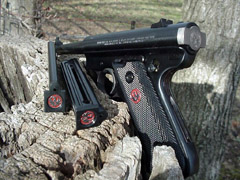
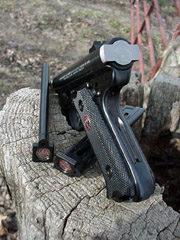

Ruger 50th Anniversary Model .22 comes complete with two
limited-edition red-medallion magazines and a limited-edition red plastic
case.
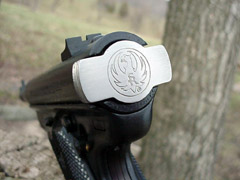
Stainless steel bolt contrasts nicely with the blued receiver, just
as did the unfinished carbon steel bolt of the original Ruger .22. The
Ruger logo roll-marked onto the back of the bolt adds an elegant touch.
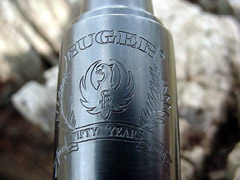
Ruger 50th Anniversary logo roll-marked on the top of the frame adds
distinction to this limited-edition commemorative.
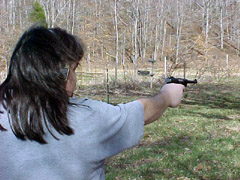
Author shoots the Ruger 50th Anniversary .22. He found that it
shoots like every other Ruger .22 he's tried - in other words, great!
  
Our buddy Bill Hamm, a longtime Ruger collector
and expert on the history of Ruger firearms, provided an early production .22 Auto "Red
Eagle" pistol for me to photograph and compare to the 50th Anniversary .22
Auto.
Click the pictures below for a larger version:

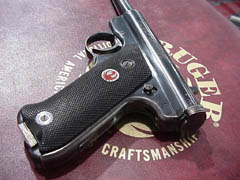
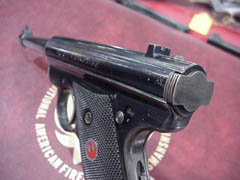
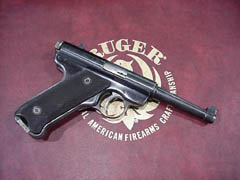
Note lack of grip medallion on right-hand side.
|
![]()